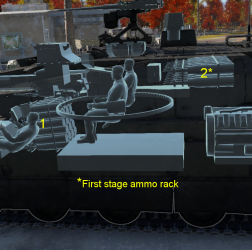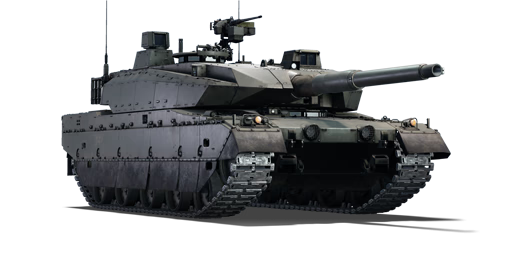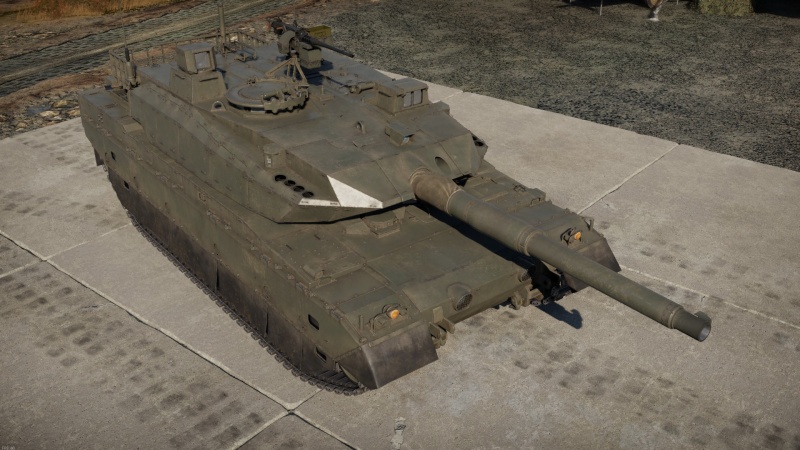Difference between revisions of "TKX"
m |
m |
||
| Line 6: | Line 6: | ||
== Description == | == Description == | ||
<!-- ''In the description, the first part should be about the history of the creation and combat usage of the vehicle, as well as its key features. In the second part, tell the reader about the ground vehicle in the game. Insert a screenshot of the vehicle, so that if the novice player does not remember the vehicle by name, he will immediately understand what kind of vehicle the article is talking about.'' --> | <!-- ''In the description, the first part should be about the history of the creation and combat usage of the vehicle, as well as its key features. In the second part, tell the reader about the ground vehicle in the game. Insert a screenshot of the vehicle, so that if the novice player does not remember the vehicle by name, he will immediately understand what kind of vehicle the article is talking about.'' --> | ||
| − | The '''{{Specs|name}}''', more precisisly the '''TKX-2''' is the | + | The '''{{Specs|name}}''', more precisisly the '''TKX-2-0005''' is the 3rd prototype towards the [[Type 10]], Developed soon after the [[Type 90 (Family)|Type 90]] to supplement and replace the aging [[Type 74 (Family)|Type 74s]] and [[Type 90 (Family)|Type 90s]]. The TKX was designed between 2002 to 2009 until it was adopted in service in 2010 as the [[Type 10]]. Its primary function was to be lighter than the [[Type 90]] with an equally effective armour, to access most Japanese infrastructure without hitting the weight limit and a bigger emphasis on {{Annotation|C4I|command, control, communication, computer & intelligence}} which couldn't properly be fitted into the [[Type 74 (Family)|Type 74s]] and [[Type 90 (Family)|Type 90s]]. |
| − | It was introduced in [[Update "Fire and Ice"]]. Being an introductory tank, and once there, a backup for the [[Type 10]]. Providing the same great firepower as that of the [[Type 90 (Family)|Type 90 MBT]], its armour and mobility will be slightly different. Being a lighter vehicle, the armour is packaged more densely and effectively to come to the same armour effectiveness, and the engine has been downgraded to save on weight. But the major selling point the TKX and Type 10 have over their bigger and older brother Type 90 is the new Type 10 APDSFS shell, which will far outshine the JM33/DM33 shell and compete with the end-tier shells of other countries. | + | It was introduced in [[Update "Fire and Ice"]]. Being an introductory tank, and once there, a backup for the [[Type 10]]. Providing the same great firepower as that of the [[Type 90 (Family)|Type 90 MBT]], its armour and mobility will be slightly different. Being a lighter vehicle, the armour is packaged more densely and effectively to come to the same armour effectiveness, and the engine has been downgraded to save on weight. But the major selling point the TKX and Type 10 have over their bigger and older brother Type 90 is the new Type 10 APDSFS shell, which will far outshine the JM33/DM33 shell and compete with the end-tier shells of other countries. The TKX also has the additional benefit of mounting a dozer blade once unlocked over the Type 10. |
== General info == | == General info == | ||
Revision as of 10:21, 9 May 2023
Contents
Description
The TKX, more precisisly the TKX-2-0005 is the 3rd prototype towards the Type 10, Developed soon after the Type 90 to supplement and replace the aging Type 74s and Type 90s. The TKX was designed between 2002 to 2009 until it was adopted in service in 2010 as the Type 10. Its primary function was to be lighter than the Type 90 with an equally effective armour, to access most Japanese infrastructure without hitting the weight limit and a bigger emphasis on C4I which couldn't properly be fitted into the Type 74s and Type 90s.
It was introduced in Update "Fire and Ice". Being an introductory tank, and once there, a backup for the Type 10. Providing the same great firepower as that of the Type 90 MBT, its armour and mobility will be slightly different. Being a lighter vehicle, the armour is packaged more densely and effectively to come to the same armour effectiveness, and the engine has been downgraded to save on weight. But the major selling point the TKX and Type 10 have over their bigger and older brother Type 90 is the new Type 10 APDSFS shell, which will far outshine the JM33/DM33 shell and compete with the end-tier shells of other countries. The TKX also has the additional benefit of mounting a dozer blade once unlocked over the Type 10.
General info
Survivability and armour
Describe armour protection. Note the most well protected and key weak areas. Appreciate the layout of modules as well as the number and location of crew members. Is the level of armour protection sufficient, is the placement of modules helpful for survival in combat? If necessary use a visual template to indicate the most secure and weak zones of the armour.
Armour type:
| Armour | Front (Slope angle) | Sides | Rear | Roof |
|---|---|---|---|---|
| Hull | ___ mm | ___ mm Top ___ mm Bottom |
___ mm | ___ - ___ mm |
| Turret | ___ - ___ mm Turret front ___ mm Gun mantlet |
___ - ___ mm | ___ - ___ mm | ___ - ___ mm |
| Cupola | ___ mm | ___ mm | ___ mm | ___ mm |
Notes:
Mobility
| Game Mode | Max Speed (km/h) | Weight (tons) | Engine power (horsepower) | Power-to-weight ratio (hp/ton) | |||
|---|---|---|---|---|---|---|---|
| Forward | Reverse | Stock | Upgraded | Stock | Upgraded | ||
| Arcade | 78 | 78 | 44.4 | 1,626 | 2,290 | 36.62 | 51.58 |
| Realistic | 71 | 71 | 1,061 | 1,200 | 23.9 | 27.03 | |
Modifications and economy
Armaments
Main armament
| 120 mm TKG | Turret rotation speed (°/s) | Reloading rate (seconds) | |||||||||||
|---|---|---|---|---|---|---|---|---|---|---|---|---|---|
| Mode | Capacity | Vertical | Horizontal | Stabilizer | Stock | Upgraded | Full | Expert | Aced | Stock | Full | Expert | Aced |
| Arcade | 35 | -7°/+10° | ±180° | Two-plane | 28.6 | 39.5 | 48.0 | 53.1 | 56.5 | 4.00 | 4.00 | 4.00 | 4.00 |
| Realistic | 17.9 | 21.0 | 25.5 | 28.2 | 30.0 | ||||||||
Ammunition
| Penetration statistics | |||||||
|---|---|---|---|---|---|---|---|
| Ammunition | Type of warhead |
Penetration @ 0° Angle of Attack (mm) | |||||
| 10 m | 100 m | 500 m | 1,000 m | 1,500 m | 2,000 m | ||
| JM12A1 | HEATFS | 480 | 480 | 480 | 480 | 480 | 480 |
| JM33 | APFSDS | 481 | 478 | 470 | 461 | 450 | 440 |
| Type 10 | APFSDS | 615 | 613 | 604 | 592 | 582 | 571 |
| Shell details | ||||||||||||
|---|---|---|---|---|---|---|---|---|---|---|---|---|
| Ammunition | Type of warhead |
Velocity (m/s) |
Projectile mass (kg) |
Fuse delay (m) |
Fuse sensitivity (mm) |
Explosive mass (TNT equivalent) (kg) |
Ricochet | |||||
| 0% | 50% | 100% | ||||||||||
| JM12A1 | HEATFS | 1,140 | 13.5 | 0.05 | 0.1 | 2.15 | 65° | 72° | 77° | |||
| JM33 | APFSDS | 1,640 | 4.3 | - | - | - | 78° | 80° | 81° | |||
| Type 10 | APFSDS | 1,780 | 4.2 | - | - | - | 78° | 80° | 81° | |||
Ammo racks

| Full ammo |
1st rack empty |
2nd rack empty |
Visual discrepancy |
|---|---|---|---|
| 35 | 15 (+20) | 1 (+34) | No |
Notes:
- Shells are modeled individually and disappear after having been shot or loaded.
- Rack 2 is a first stage ammo rack. It totals 14 shells and gets filled first when loading up the tank.
- This rack is also emptied early: the rack depletion order at full capacity is: 2 - 1.
- If you pack 15 (+20) shells, it will keep the hull empty of ammo.
- Simply not firing when the gun is loaded will move ammo from rack 1 into rack 2. Firing will interrupt the restocking of the ready rack.
Machine guns
| 12.7 mm M2HB | ||||
|---|---|---|---|---|
| Mount | Capacity (Belt) | Fire rate | Vertical | Horizontal |
| Pintle | 1,000 (200) | 577 | -8°/+60° | ±180° |
| 7.62 mm Type 74 | ||||
|---|---|---|---|---|
| Mount | Capacity (Belt) | Fire rate | Vertical | Horizontal |
| Coaxial | 3,000 (250) | 701 | N/A | N/A |
Usage in battles
Describe the tactics of playing in the vehicle, the features of using vehicles in the team and advice on tactics. Refrain from creating a "guide" - do not impose a single point of view but instead give the reader food for thought. Describe the most dangerous enemies and give recommendations on fighting them. If necessary, note the specifics of the game in different modes (AB, RB, SB).
Pros and cons
Pros:
- Small profile
- Autoloaded 120 mm cannon
- Great mobility
Cons:
- Poor armour
- Slow elevation/depression speed
History
Describe the history of the creation and combat usage of the vehicle in more detail than in the introduction. If the historical reference turns out to be too long, take it to a separate article, taking a link to the article about the vehicle and adding a block "/History" (example: https://wiki.warthunder.com/(Vehicle-name)/History) and add a link to it here using the main template. Be sure to reference text and sources by using <ref></ref>, as well as adding them at the end of the article with <references />. This section may also include the vehicle's dev blog entry (if applicable) and the in-game encyclopedia description (under === In-game description ===, also if applicable).
Media
- Skins
See also
External links
| Japan medium tanks | |
|---|---|
| Type 97 | Chi-Ha · Chi-Ha Kai · Chi-Ha Kai TD · Chi-Ha Short Gun |
| Type 1 | Chi-He · Chi-He (5th Regiment) · Ho-I |
| Type 3 | Chi-Nu · Chi-Nu II |
| Type 4 | Chi-To · Chi-To Late |
| Type 5 | Chi-Ri II |
| Type 61 MBT | ST-A1* · ST-A2* · ST-A3* · Type 61 |
| Type 74 MBT | ST-B2* · Type 74 (C) · Type 74 (E) · Type 74 (F) · Type 74 (G) |
| Type 90 MBT | Type 90 · Type 90 (B) · Type 90 (B) "Fuji" |
| Type 10 MBT | TKX (P)* · TKX* · Type 10 |
| Other | Ka-Chi |
| USA | ▅M4A3 (76) W · ▅M47 |
| *Prototype | |
- Ground vehicles
- Japan ground vehicles
- Eighth rank ground vehicles
- Medium tanks
- Ground vehicles with composite armour
- Ground vehicles with smoke grenades
- Ground vehicles with dozer blade
- Ground vehicles with hydropneumatic suspension
- Ground vehicles with night vision device
- Ground vehicles with thermal sight
- Ground vehicles with autoloader
- Ground vehicles with gun stabilizer





